
John Laurens

William Bolt

Leslie Burton

Albert Royston

Leonard Wardill

Robert Christie
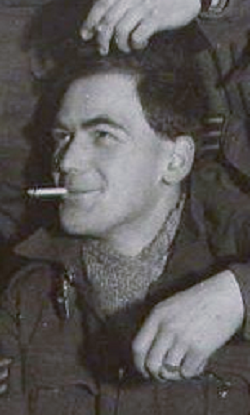
William Kibble

Cassian Waight

John Laurens

William Bolt

Leslie Burton

Albert Royston

Leonard Wardill

Robert Christie

William Kibble

Cassian Waight
Lancaster DV267 was a Mark III Lancaster bomber that Chris flew on as Bomb Aimer at least nine times, on
six ops (one abandoned due to engine fire) with pilot John Laurens.
It flew with a crew of eight as it included an ABC operator (Airborne Cigar – on-board German-speaking radio
jamming operator and equipment).
Chris was filling in for Bomb Aimer Jacques Marchant who had a bout of flu. Chris was replaced by Ronald
Aitken who ended up having only three Ops with the crew.
When the crew failed to return on 20 Feb, Jacques Marchant decided to return home to Canada.
Berlin 2 Dec – This trip was one mentioned in pilot Laurens’ DFM citation as follows – On the night of 2nd December, 1943 when attacking Berlin, he was coned by searchlights and very severely damaged by flak. When on the run-up to bomb, his aircraft was thrown out of control but with magnificent skill, he remained on an even keel and with splendid determination went on and released his bombs in the target area.
Berlin 20 Jan – They were caught in a dramatic thunderstorm on the way home. There was two hours of incessant lightning and hail with slabs of ice thrown from the props onto the fuselage. The flight engineer had to help Laurens hold the central column steady as the vibration was so intense with blue lights running around the window frames and jumping across the gun barrels.
Magdeburg 21 Jan – Another Lancaster passed over the top of theirs, coming so close it removed the aerial mast next to the astro dome. The mid upper turret was smashed by the mast.
Berlin 27 Jan – This was Chris’ 30th and final Op. He left the crew and moved to training.

Jack Laurens
Pilot
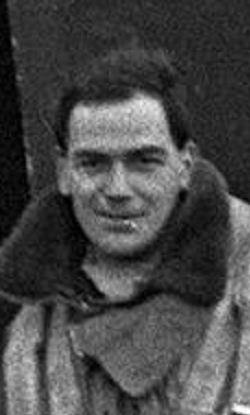
Alex Kibble
Flight Engineer
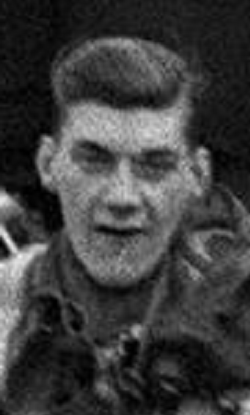
Les Burton
Navigator
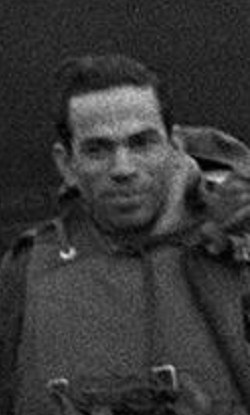
Cas Waight
Wireless Op
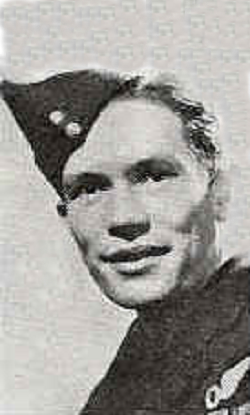
Ron Aitken
Bomb Aimer
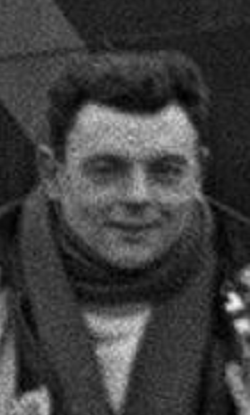
Ted Royston
Rear Gunner
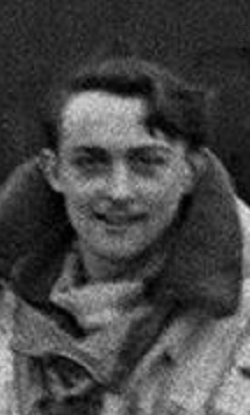
Don Bolt
Mid-Upper Gunner
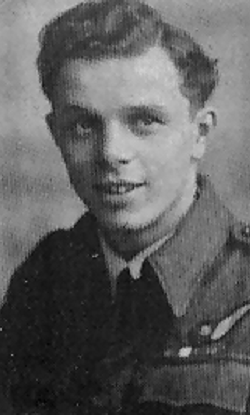
Jim Davies
ABC Operator
This was the third Op for this updated crew following Chris’ departure. For James Davies it was only his
second Op overall.
The night of 19/20 Feb 1944 was a major offensive to Leipzig. It turned out to have the heaviest bomber losses
up to that time. DV267 was one of the 78 aircraft that
failed to return (but the only one from 101 Squadron).
The bomber took off from RAF Ludford Magna at 23:38. Twenty two aircraft from 101 squadron were part of a
force of 823 aircraft on the mission.
The weather was freezing with heavy rain and very low cloud. The winds were forecast at 100mph and they were
but Les Burton found them coming from a different direction,
meaning some hasty recalculations. Laurens did a series of dog-legs to lose time and try to not arrive at the
target too early.
Contact
While over German-occupied Friesland, Wireless Operator Cassian Waight reported a fighter showing up on his
equipment. Laurens prepared to make an escape manoeuvre and put the aircraft into a
corkscrew, but Waight followed up almost immediately with ‘It’s all right – he is going away’. However it was
not all right.
A loud noise followed by tongues of flame light up the sky – shots from the night fighter. The fighter was a
Bf 100G-4 – a German fighter fitted with upward firing guns. Flames poured
in from the direction of the port outer engine. Laurens and Kibble assumed one of the port-wing engines was on
fire. This had happened two or three times previously and they knew what to do.
The fire extinguishers were put to work, the propeller was stopped and ‘feathered’. The port wing engine
stopped burning. Alex switched all four engines onto the starboard centre tank in order
to use up as much fuel as possible. But the fire increased in intensity; the wing tanks between the port side
engines had been holed and each tank containing 400 gallons of fuel was ablaze.
Bailing out
They could not make it to the target and had to turn for home. Laurens considered heading for the North Sea
but Les convinced him they wouldn’t make it. Plus ditching in the freezing
North Sea in 100mph winds at 2.40am was not attractive. The decision was taken to bale out. The bombs were
jettisoned.
The rear door was stuck – Laurens ordered them in colourful language to smash it open with an axe. At the same
time the front hatch in the nose was also stuck – Aitken and Kibble managed to clear it.
Burton clipped a parachute to Lauren’s chest. This was routine procedure but in practice pointless – pilots
had little chance of escape as they stayed with the aircraft until the rest of the crew had
jumped. At this point the port wing fell off. The starboard wing and then the nose went down. Laurens gave his
final order – to abandon the aircraft.
Laurens stayed at the controls and was killed when the aircraft crashed. The stories of the crew are below.

Name – John J Laurens DFM
Service no – 171908 / 657916
Role – Pilot
Born – 1918, Wolseley, Cape Province, South Africa, age 26
Outcome – Killed
John Laurens was born in Wolseley, 50 miles East of Cape Town in South Africa. He was the son of Jan
Gerhardus Laurens and Maria Elizabeth Laurens.
He was married to Margaret J. Cooke of Ferryhill in Westminster and had a son, John Frederick Laurens, born
in 1939 (d 2015).
Laurens served with the navy, army (Grenadier Guards 1936-40) and was mentioned in despatches of the Dunkirk
evacuation. He then joined the RAF, becoming a bomber pilot.
The night of 19/20 Feb was his 20th op. He stayed at the controls, trying to control the plane and let
everyone else escape. He was killed and his body found in the wreckage of the aircraft.
He is buried in the Protestant Church in Tolbert, Netherlands.

Name – William Frederick Donald Bolt
Service no – 1587851
Role – Mid-upper Gunnder
Born – Early 1922, Plympton, Plymouth, age 22
Outcome – Killed
William Bolt was the son of William James Bolt and Elsie May Eames. He was from Plympton in Plymouth,
Devon.
He volunteered and enlisted in Weston-Super-Mare.
This was his 23rd Op. The rear escape door was jammed but after it was freed he managed to successfully bale
out, ahead of James Davies who saw him leave.
Either his parachute failed to open or he may have hit the falling aircraft and so not been able to activate
the parachute. His parachute did not open and he was killed.
He is buried next to John Laurens in Tolbert, Netherlands.
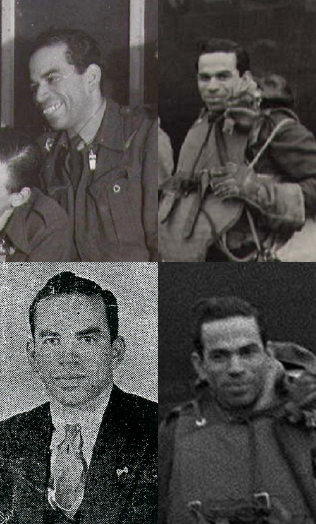
Name – Cassian Henry Waight
Service no – 172841
Role – Wireless Operator
Born – 30 April 1911, British Honduras / Belize, age 32
Outcome – Killed
Cassian Henry Waight was the son of John Woods Waight and Lottie Evelyn Gladys Waight of Belize, British
Honduras. He was married and the father of 4 children.
He was the wireless operator and reported the fighter on his equipment.
Wearing a parachute impeded his work so he did not normally wear it. According to Jim Davies, he had been
told many times by Laurens and Burton to wear his parachute but had refused.
He was caught in the fire in the plane and was thrown out of the aircraft without a parachute.
He is buried in Marum Protestant Churchyard in Noordwijk, Netherlands.
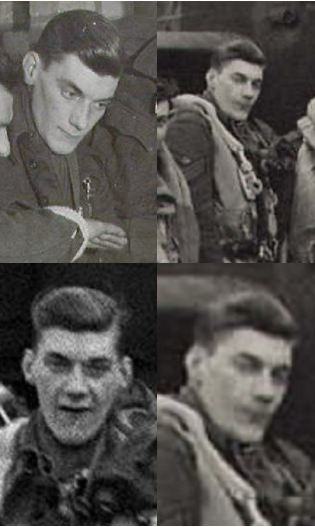
Name – Leslie Burton
Service no – 1451691
Role – Navigator Born – 1922, Calverley, Yorkshire, age 22
Outcome – Survived. Evaded capture with Kibble for 3 months
Captured – 3 May 1944 in The Hague, POW 3843, Stalag 357 (Thorn then Fallingbostel)
Died – 1992
Leslie Burton was from Leeds and enlisted at Cardington. He was the navigator.
The Lancaster went into a spin, there was a flash and he momentarily blacked out. In his words, as related
by Jim Davies –
‘When I came round I seemed to be floating on a black velvet cloth covered in diamonds. No sensation
of falling; nothing but peaceful quietness.
How long this went on I have no idea… The diamonds were slowly moving round and a feeling of coldness
seemed to strike me. I came round fast.
I was in a free fall.
The diamonds were stars. It was very, very cold. I was out of the plane. Had I really got out of that
plane?
I had no problems in moving my arms and I brought my right arm to my chest and groped and clawed where the
ripcord should be.
I was clawing on canvas. Even now I didn’t seem to feel scared and reasoned that I must have clipped the
chute the wrong way round.
I brought my left hand up and there was the cord … I pulled, there was a bit of a delay, a loud crack, and
I felt as if someone had kicked me in the wedding tackle – hard.
I landed mostly on my face in the back yard of a farmhouse.’
He had injured his leg so he crawled to the front door and knocked.
He subsequently met with the Buiter family in Tolbert who sheltered him and met up with Kibble and they were
then helped by various members of the Dutch resistance.
They were eventually betrayed and ended up at Stalag 357 in Thorn, Poland.
The Stalag 357 camp and prisoners were later relocated West to Fallingbostel. Prisoners were loaded onto
train trucks for several days in unsanitory conditions.
In the final days of the war, the prisoners were marched North East. The guards eventually agreed to them
marching towards advancing British lines and liberation in Apr/May 1945.

Name – William Alexander George Kibble
Service no – 1802466
Role – Flight Engineer
Born – Hatfield
Outcome – Survived. Evaded capture with Burton for 3 months
Captured – 3 May 1944 in The Hague, POW 3848, Stalag 357
William Kibble enlisted in Euston.William Kibble enlisted in Euston.
Flight Engineer Billie Kibble successfully parachuted out and was subsequently sheltered in hiding, joining
up with Leslie Burton.
They evaded capture for some time but eventually became POWs, ending up at Stalag 357 in Poland, then
Germany.

Name – Albert Edward Royston
Service no – 647141
Role – Rear Gunner
Born – Darfield near Barnsley
Outcome – Survived. Captured immediately (knocked on the wrong door!)
Captured – 20 Feb 1944, POW 1902. Dulag Luft (Luftwaffe interrogation camp). 5/3/44 Stalag Luft 6. Then
moved to Stalag 357.
Albert Royston enlisted in the RAF as a civilian in 1938.
On the night of 19/20 Feb he successfully parachuted out of the rear exit, ahead of Bolt and Davies.
After landing he knocked on a door for assistance but unfortunately it was a Nazi sympathiser and he was
immediately given up.
He was sent as a POW to Dulag Luft, arriving 5/3/44 at Stalag Luft 6 (Šilutė in Lithuania).He then moved to
Stalag 357.
This was in Thorn, Poland before being moved in Sep 1944 near the town of Fallingbostel in NW
Germany.
In Apr 1945 prisoners from Stalag 357 were forced to march North East in the face of the Allied advance.
The British camp leader confronted the German commander – surrender to the British or Russians.
This lead to the POW column marching back to the advancing British lines and liberation.
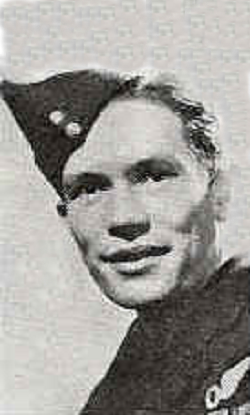
Name – Ronald Norman Aitken
Service no – 1509571
Role – Bomb Aimer
Born – 2 Sep 1922, Oldham, age 21
Outcome – Survived. Evaded capture with Davies for 6 months
Captured – 10 Aug 1944, POW 609, Dalag Luft then Stalag Luft 7, Bąków / Poland. Jan 45 – 300 mile force
march to Stalag III-A
Died – Jun 1994
Ronald Aiken enlisted in the RAF at Padgate.
On the night of 19/20 Feb he successfully jettisonned the bombs. He and Alex Kibble then managed to release
the hatch in the nose of the plane and parachuted out.
He was hidden overnight by a Mr Bijzitter and then helped by Mr Van Jeep. He was taken to the Wijkstra home
where he emotionally met up with Davies.
They were then hidden for 6 months by the Dijkstra family in Garjip. An escape was arranged back to the
advancing British lines but they were betrayed and captured 10 Aug 1944 by the Gestapo.
They were held in Antwerp jail, St Giles prison and then onto Dulag Luft for interrogation before being sent
to Stalag Luft 7 in Bankau, Poland.
On 19 Jan 1945 the whole camp was ordered on a forced march West, away from the advancing Soviet army
(called ‘The March‘ – forced marches of over 80000 POWs in extreme weather conditions).
They marched for two and a half weeks, over 300 miles in freezing conditions, ending up at Peterwitz then
onto transport reaching Stalag III-A near Luckenwalde on 8 Feb 1945.
The Soviet army arrived on 22 Apr but most of the prisoners were not allowed to leave until 20 May. Aitken
is listed as missing on 8 May so likely left before then.
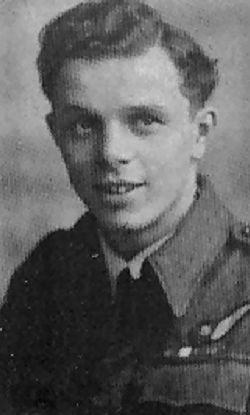
Name – James Arthur Davies
Service no – 1651898
Role – ABC Operator
Born – 12 Jan 1923, Boncath, Pembrokeshire
Outcome – Survived. Evaded capture with Aitken for 6 months
Captured – 10 Aug 1944, POW 698, Dulag Luft then Stalag Luft 7 Bąków / Poland, then Stalag III-A
Died – 17 Feb 2007
ABC Special Operator Jim Davies was the German speaking operator listening in for German transmissions and
then jamming those frequencies. This was only his second Op.
He was one of the last of the crew to parachute out of the burning aircraft. He hid and then walked
overnight for the next three days before approaching a farmer for assistance.
He quickly handed him onto his neighbour who gave him clothes and a bicycle. They moved to the farmer’s
brother in law’s where he stayed overnight.
From there to a local schoolmaster and another farm where he stayed for two days. At this point he met up
with Ronald Aitken who had also been hidden by the Resistance though.
From other references it seems definite that Aitken and Davies hid together, though Davies does not mention
Aitken in his book.
During this time a local policeman (a member of the Resistance) brought him a little perspex heart with the
letters SA and a South African flash on it. They
had found this on Laurens and also told him about the bodies of Bolt and Waight.
Then onto the the head of the local resistance for questioning and the home of the Dijkstra family in Garjip
where they stayed for five months.
Following D-Day an escape was planned via Belgium to be picked up by the advancing Allied
troops.Unfortunately the guide in Belgium was a collaborator and handed them over to the Gestapo.
As Aitken, it was then off to Antwerp Jail, St Giles prison, Dulag Luft and on to Stalag Luft 7 POW camp in
Bankau, Poland.
On 19 Jan 1945, along with Aitken and the other prisoners, he was forced to march over 300 miles over two
and a half weeks in extreme conditions West away from the advancing Soviet army,
ending up at Stalag III-A.
On 21 April the German guards ran off with the Russians arriving on 22 April. However the Russians did not
let them leave until 20 May, almost two weeks after VE day.
Then it was to the American base at Leipzig, a flight back to Brussels and an RAF flight back to the UK – in
a Lancaster! He arrived home two days later.